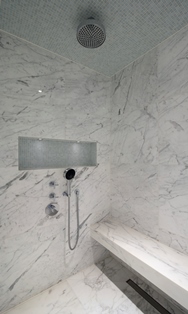Advice for Tiling on Plasterboard
To sum it up in one word - DON'T! Here's why....
As a member of the Tile Association and the Stone Federation of Great Britain, we have access to some really useful information that our customers can also benefit from.
The following article is a summary taken from the Tile Association and the Stone Federation's web sites and it discusses the substrate or base that is often used when tiling walls. This is such an important consideration but often overlooked by the novice DIYer:

When undertaking any tiling project one of the key considerations must be whether the wall can take the weight of the tiles.
The maximum weight of tiling which can be supported by a dry, well-adhered plaster background is 20kg/m². This is equivalent to ceramic tiles with a maximum thickness of 8mm plus tile adhesive or natural stone tiles with a maximum thickness of 7mm plus tile adhesive.
(Most natural stone is at least 10mm thick and often up to 20mm thick)
The weight of tiling to a plasterboard background direct (without plaster skim) should not exceed 32kg/m². This is equivalent to a ceramic tile and adhesive with a maximum thickness of 12.5mm and natural stone and adhesive with a maximum thickness of 10mm.
(When you add in the adhesive, even a 10mm thick natural stone tile will end up being a minimum of 13mm thick - too heavy for plasterboard!)
It is important to emphasise that the weights quoted includes both the tile and adhesive.
Further advice should be sought either from the manufacturer, regarding the suitability of the adhesives and grouts and also guidance must be sought from board manufacturer regarding additional information on recommended methods for the installation of boards.
 The following offers general guidance to some common types of building board and the maximum recommended weights for tiling.
The following offers general guidance to some common types of building board and the maximum recommended weights for tiling.
| Wall Substrates with maximum weight of tiling per m²: | |
| Gypsum plaster | 20kg/m² |
| Gypsum plasterboard direct (without a plaster skim) | 32kg/m² |
| Plywood (WBP) | up to 30kg/m² |
| Lightweight tilebacker boards - Up to 40kg/m² | up to 40kg/m² * |
| Glass reinforced cement sheets - Up to 50kg/m² | up to 50kg/m² * |
| Gypsum fibre boards | approx 35-40kg/m² |
* Dependant upon the type and thickness of the board.
When tiling walls, particularly in bathrooms or wet areas, we like to use Marmox tilebacker boards. These have been tested to hold well over 60 kgs per square metre and will therefore take even a 20mm thick marble tile and adhesive quite comfortably.
Another advantage is that the Marmox boards are waterproof and do not allow moisture to pass through them. Plasterboard, on the other hand (and even the green "moisture resistant" plasterboard), will let water through and will swell when it gets wet. This will lead to tiles falling off the wall and potential leaks through to other rooms. This is a very common error and is to blame for most tiling failures in shower enclosures and bathrooms. You can read more about the dangers of tiling on plasterboard on our blog: How 4 common myths cause leaks in your bathroom.
See the Marmox web site for more details.
Update: There are more hints and tips on choosing and installing natural stone on our recent blog: http://info.amarestone.com/blog/homebuilding-show-nec-2016-masterclass
Our brochure explains how we work and how we can help your natural stone project be successful.
Thanks for reading.
Steve Turner
0345 260 8070
Amarestone
Thanks for reading.
Steve Turner
0345 260 8070
P.S. - get the next blog direct to your inbox by entering your email address in the box on this page.


